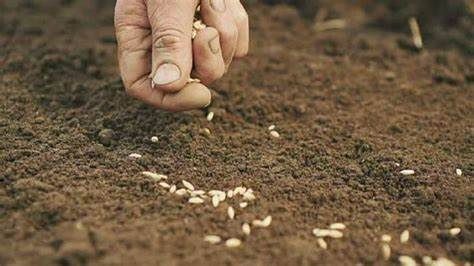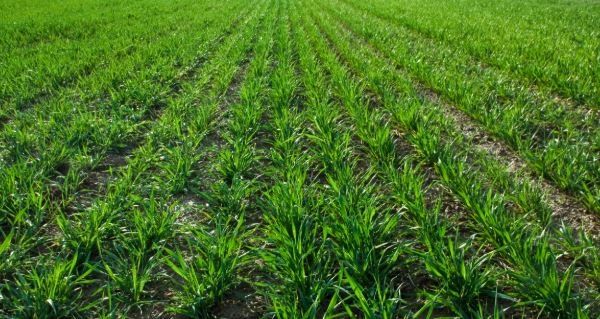Learn about the best types of fertilizers for agriculture, including organic, inorganic, and slow-re ...
Wheat is one of the major rabi crops in India, and proper field preparation and the use of the right fertilizer are crucial for achieving a good yield. Maintaining soil fertility is essential to maximize crop productivity. In this article, we will provide detailed information on the types of fertilizers to use during wheat sowing and their application.
गेहूं भारत की प्रमुख रबी फसलों में से एक है, और इसकी अच्छी उपज के लिए खेत की तैयारी और सही खाद का उपयोग बेहद जरूरी है। फसल की उत्पादकता को बढ़ाने के लिए मिट्टी की उर्वरता बनाए रखना अनिवार्य है। इस लेख में, हम आपको गेहूं की बुवाई के समय उपयोग किए जाने वाले खाद और उसकी मात्रा के बारे में विस्तृत जानकारी देंगे...
गेहूं की बुवाई से पहले मिट्टी की जांच कराना अत्यंत आवश्यक है। मिट्टी जांच से आपको यह पता चलता है कि कौन से पोषक तत्वों की कमी है और आपकी फसल को किन पोषक तत्वों की अधिक आवश्यकता है। इस जानकारी के आधार पर आप सही प्रकार और मात्रा में खाद का चयन कर सकते हैं।
गेहूं की फसल को उर्वरक तत्व जैसे नाइट्रोजन, फॉस्फोरस, और पोटाश की आवश्यकता होती है। बुवाई के समय निम्नलिखित खादों का उपयोग करें:

खेत में बुवाई से 15-20 दिन पहले 8-10 टन सड़ी-गली गोबर की खाद डालें। जैविक खाद मिट्टी की संरचना और उर्वरकता को बेहतर बनाती है।
DAP (डाय-अमोनियम फॉस्फेट): बुवाई के समय प्रति एकड़ 50-60 किलो DAP का उपयोग करें। इसमें 18% नाइट्रोजन और 46% फॉस्फोरस होता है, जो फसल की जड़ों को मजबूत करता है।
यूरिया (नाइट्रोजन): बुवाई के समय 1/3 भाग नाइट्रोजन के रूप में 20-25 किलो यूरिया डालें। शेष 2/3 भाग टॉप ड्रेसिंग के रूप में बुवाई के 30 और 60 दिन बाद दें।पोटाश (MOP): बुवाई के समय प्रति एकड़ 20-25 किलो म्यूरिएट ऑफ पोटाश (MOP) का उपयोग करें। यह फसल की रोग प्रतिरोधक क्षमता को बढ़ाता है।
खाद डालने के बाद उसे मिट्टी में अच्छी तरह से मिला दें। इसके लिए रोटावेटर या हल का उपयोग करें। सुनिश्चित करें कि खाद का संतुलित उपयोग हो और खेत में नमी की उचित व्यवस्था हो।

बुवाई के 30 और 60 दिनों बाद यूरिया का छिड़काव करें। हर टॉप ड्रेसिंग के बाद हल्की सिंचाई करना सुनिश्चित करें।
यह भी पढ़ें: गेहूं की खेती | गेहूं की किस्में
खाद डालने के तुरंत बाद सिंचाई न करें। अधिक मात्रा में रासायनिक खाद का उपयोग न करें, यह मिट्टी की उर्वरकता को नुकसान पहुंचा सकता है। जैविक और रासायनिक खाद का संतुलित उपयोग करें।
गेहूं की बुवाई के समय सही खाद का चयन और उचित मात्रा में उसका उपयोग फसल की उपज बढ़ाने में सहायक होता है। जैविक और रासायनिक खाद का संतुलित उपयोग न केवल फसल को पोषण देता है, बल्कि मिट्टी की उर्वरता को भी बनाए रखता है। यदि आप इन बिंदुओं का ध्यान रखेंगे, तो आपकी गेहूं की फसल से बेहतर उत्पादन प्राप्त होगा।
Conducting a soil test before wheat sowing is very important. Soil testing helps determine the nutrient deficiencies in the soil and the specific nutrients your crop needs. Based on the test results, you can select the right type and quantity of fertilizers.
Wheat crops require essential nutrients like nitrogen, phosphorus, and potash. Here are the fertilizers to use during sowing:
Apply 8-10 tons of well-decomposed farmyard manure (FYM) 15-20 days before sowing. Organic fertilizers improve soil structure and fertility.
DAP (Di-Ammonium Phosphate): Use 50-60 kg of DAP per acre during sowing. It contains 18% nitrogen and 46% phosphorus, which strengthen the crop’s roots.
Urea (Nitrogen): Apply 1/3rd of the required nitrogen as urea during sowing (around 20-25 kg per acre). The remaining 2/3rd nitrogen should be applied as top dressing 30 and 60 days after sowing.
Potash (MOP): Use 20-25 kg of Muriate of Potash (MOP) per acre during sowing. It enhances the crop’s resistance to diseases.
After applying fertilizers, mix them well into the soil. Use a rotavator or plow to ensure even distribution. Maintain proper soil moisture levels for better nutrient absorption.
Apply the remaining urea in two phases, 30 and 60 days after sowing. Always ensure light irrigation after top dressing.
Avoid irrigation immediately after applying fertilizers. Do not overuse chemical fertilizers, as it can harm soil fertility. Maintain a balanced use of organic and chemical fertilizers.
Using the right fertilizers in appropriate quantities during wheat sowing plays a crucial role in improving crop yield. A balanced application of organic and chemical fertilizers not only nourishes the crop but also maintains soil fertility. By following these tips, you can ensure a healthier and more productive wheat crop.
0
0
Learn about the best types of fertilizers for agriculture, including organic, inorganic, and slow-re ...
Vermicompost, also known as worm compost, is an organic fertilizer made from decomposed organic wast ...
Fertilizers are essential for increasing the productivity of crops and maintaining soil fertility. A ...
In the cultivation of Rabi crops, maintaining the right balance of nutrients is crucial for achievin ...